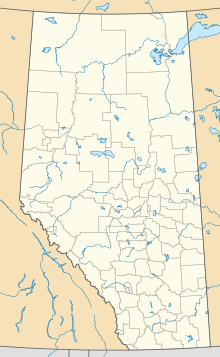Waterton Park
Waterton Park | |
|---|---|
 View from above of Waterton Park | |
Location of Waterton Park in Alberta | |
| Coordinates: 49°03′06″N 113°54′51″W / 49.0517°N 113.9142°W | |
| Country | Canada |
| Province | Alberta |
| Census division | No. 3 |
| Improvement District | Improvement District No. 4 Waterton |
| Government | |
| • Type | Unincorporated |
| • Governing body | Alberta Municipal Affairs |
| Area (2021)[1] | |
| • Land | 482.54 km2 (186.31 sq mi) |
| Elevation | 1,280 m (4,200 ft) |
| Population (2021)[1] | |
| • Total | 158 |
| • Density | 0.3/km2 (0.8/sq mi) |
| Time zone | UTC−7 (MST) |
| • Summer (DST) | UTC−6 (MDT) |
| Area code | 403 / 587 |
| highways | |
Waterton Park, commonly referred to as Waterton, is a hamlet in southwestern Alberta, Canada within Improvement District No. 4 Waterton (Waterton Lakes National Park).[2]
It is located at the southwestern terminus of Highway 5, approximately 54 kilometres (34 mi) west of the Town of Cardston and 55 kilometres (34 mi) south of the Town of Pincher Creek. This hamlet is north of Glacier National Park in Montana. It has an elevation of 1,280 metres (4,200 ft).
The hamlet is located in Census Division No. 3 and in the federal riding of Lethbridge.
Demographics[edit]
In the 2021 Census of Population conducted by Statistics Canada, Waterton Park had a population of 158 living in 67 of its 209 total private dwellings, a change of 50.5% from its 2016 population of 105. With a land area of 482.54 km2 (186.31 sq mi), it had a population density of 0.3/km2 (0.8/sq mi) in 2021.[1]
As a designated place in the 2016 Census of Population conducted by Statistics Canada, Waterton Park had a population of 105 living in 39 of its 168 total private dwellings, a change of 19.3% from its 2011 population of 88. With a land area of 485.66 km2 (187.51 sq mi), it had a population density of 0.2/km2 (0.6/sq mi) in 2016.[3]
Climate[edit]
Waterton Park has a humid continental climate (Köppen Dfb), just above the subarctic climate (Dfc). Summers are mild with cool nights, while winters are chilly with highs around freezing. Precipitation is relatively consistent year round, but peaks during the months of May and June.[4]
| Climate data for Waterton Park | |||||||||||||
|---|---|---|---|---|---|---|---|---|---|---|---|---|---|
| Month | Jan | Feb | Mar | Apr | May | Jun | Jul | Aug | Sep | Oct | Nov | Dec | Year |
| Record high °C (°F) | 15 (59) |
17 (63) |
20 (68) |
26.5 (79.7) |
30 (86) |
31 (88) |
34.5 (94.1) |
34 (93) |
32.8 (91.0) |
29 (84) |
19 (66) |
20 (68) |
34.5 (94.1) |
| Mean daily maximum °C (°F) | 0.3 (32.5) |
1.3 (34.3) |
5.3 (41.5) |
10 (50) |
15 (59) |
19 (66) |
22.5 (72.5) |
22 (72) |
17.3 (63.1) |
11.8 (53.2) |
3.1 (37.6) |
−0.3 (31.5) |
10.6 (51.1) |
| Mean daily minimum °C (°F) | −10.6 (12.9) |
−9.8 (14.4) |
−5.5 (22.1) |
−1.5 (29.3) |
2.8 (37.0) |
6.1 (43.0) |
7.9 (46.2) |
6.9 (44.4) |
3.4 (38.1) |
0.6 (33.1) |
−5.8 (21.6) |
−9.7 (14.5) |
−1.3 (29.7) |
| Record low °C (°F) | −40.5 (−40.9) |
−50 (−58) |
−34.4 (−29.9) |
−24.4 (−11.9) |
−11 (12) |
−6 (21) |
−3 (27) |
−5 (23) |
−12 (10) |
−27 (−17) |
−34 (−29) |
−44.5 (−48.1) |
−50 (−58) |
| Average precipitation mm (inches) | 59.3 (2.33) |
46.3 (1.82) |
69.3 (2.73) |
64.5 (2.54) |
94.5 (3.72) |
80.8 (3.18) |
70.8 (2.79) |
69 (2.7) |
60.8 (2.39) |
65.1 (2.56) |
68.7 (2.70) |
58.4 (2.30) |
807.6 (31.80) |
| Source: Environment Canada[5] | |||||||||||||
See also[edit]
References[edit]
- ^ a b c "Population and dwelling counts: Canada and designated places". Statistics Canada. 9 February 2022. Retrieved 10 February 2022.
- ^ "Specialized and Rural Municipalities and Their Communities" (PDF). Alberta Municipal Affairs. 12 January 2022. Retrieved 21 January 2022.
- ^ "Population and dwelling counts, for Canada, provinces and territories, and designated places, 2016 and 2011 censuses – 100% data (Alberta)". Statistics Canada. 8 February 2017. Retrieved 13 February 2017.
- ^ Canada, Environment and Climate Change (19 January 2011). "Canadian Climate Normals 1971-2000 Station Data - Climate - Environment and Climate Change Canada". climate.weather.gc.ca. Retrieved 19 May 2020.
- ^ Environment Canada—Canadian Climate Normals 1971–2000, accessed 23 March 2010

